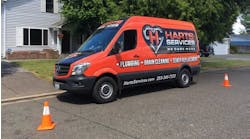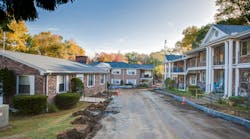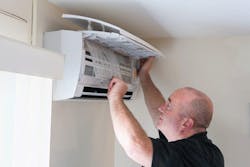MARLBOROUGH, MASS. — On November 1, 2014, New England businesses and residents that draw power from National Grid utility saw a 40 percent jump in the cost per kilowatt hour. Adapting to the change is hardest for the area’s low income population. But there is some reprieve.
Action for Boston Community Development (ABCD) is one of 25 agencies that make up the Low-income Energy Affordability Network (LEAN). Through funding from the Massachusetts Clean Energy Center, LEAN is making energy efficiency upgrades at low-income housing facilities throughout the state by focusing on biomass and air-source heat pump technologies for retrofits.
“We seek retrofit applications where funding can make the biggest impact,” said Bruce Ledgerwood, program manager for the LEAN Alternative Energy Program. “The overall goal is to reduce heating costs, diminish the carbon footprint of public housing, and train installers on the use and installation of technologies that might be new to them.”
Earlier in the year, Marlborough Community Development Authority’s Pleasant Street Apartments became the pilot project for a high-efficiency retrofit model which could later be applied to other facilities in the area. They are the public housing authority for the City of Marlborough. The four-building complex was built in 1966, and was previously heated with electric resistance baseboard and cooled with window units. It features dorm-style housing for elderly, low-income residents.
Given the compact floor plans and solid concrete construction at Pleasant Street, ductless mini-split technology quickly appeared as the best choice for the retrofit.
The goal for the retrofit was to achieve a 36 percent reduction in heating energy use, but a kilowatt hour reduction of 50 percent is actually expected. The work was bid by six mechanical firms, and in May, two were selected to retrofit 15 apartment units each.
Three a day
“The apartments are roughly 500 square feet,” said Shawn Kelley, owner of Nashoba Air & BoilerWorks, Littleton, Mass. “They consist of a kitchenette, living room, bedroom and bathroom. A single Fujitsu 12,000 BTU ductless split system now completely conditions each flat. A Tjernlund Airshare through-wall fan shares conditioned air with the bedroom even if the door is closed.
Most of the apartments have a patio or concrete deck outside the living room, where Nashoba technicians placed the single-zone compressor. A 10-ft. line-set runs through the wall to the evaporator. Penetrating the building envelope for line-sets wasn’t a challenge, according to Kelley. But the condensate lines were more difficult.
“The two floors are separated by a four-inch slab of reinforced concrete with an overhanging four-foot patio and walkway,” explained Kelley. “The difficult part was plumbing the lines so that condensation wouldn’t pool on the decks and create a hazard. We decided to drill through the decks and drop each of the condensate lines to the ground away from foot travel.”
The Massachusetts Department of Housing & Community Development also funded upgrades to the utility boxes for those apartments receiving the new ductless split system. When Nashoba’s electrician ran power supply for the new units, the 24-in. crawlspace wasn’t accommodating. But it didn’t slow progress.
“The only other challenge was initially explaining to tenants that yes, this one tiny little unit will heat and cool your entire apartment,” said Kelley. “The heat load calculation didn’t mean too much to them. But in August, when it got hot outside, they quickly became believers.” The Fujitsu RLS2H systems that Nashoba uses for projects like this heat efficiently even when ambient temps fall to -15°F and offer efficiencies up to 27.5 SEER.
“We’ve been installing Fujitsu systems for 13 years,” continued Kelley. “Their distribution network is great and the units are headache-free. Ductless technology has come so far over the past decade. You don’t have issues unless the installer didn’t weigh the refrigerant charge.”
Solid solution
Two weeks after Nashoba completed their first 15 units, the housing authority decided to move forward with retrofitting an additional 12 units immediately.
“There were a few fringe benefits that we hadn’t anticipated,” said Ledgerwood. “Tenants say that getting rid of the window units add light to the rooms. Also, the ductless systems are much quieter and cleaner. From a maintenance standpoint, nobody is handling or storing window units, either.”
“The work that Nashoba Air & BoilerWorks did was fantastic,” said Douglas Bushman, housing director for Marlboro Community Development Authority. “We were impressed with how quickly the new units were installed, and how little disruption there was to the buildings in the process. Their staff were courteous to our tenants and overall a professional group of people to work with.”
Today, ductless work accounts for roughly 30 percent of the company’s business; up from 25 percent last year. Most of that work is residential, although doctor and dental offices are increasingly interested in ductless technology. With 22 employees, Nashoba Air & BoilerWorks serves Northeast Massachusetts and Southeast New Hampshire, and recently moved to a newly- renovated 18,000-sq.ft. facility.
In October, monitoring equipment was installed on 10 electric meters; five with new Fujitsu systems, and five that haven’t been retrofitted. The 2014/2015 heating season will be telling.
“I’m confident we’ll hit the target savings number,” said Bushman. “There should be many more apartments retrofitted with ductless units next year. And with the recent spike in energy cost, it’ll take much less time to see payback than we had initially anticipated. Personally, I think the window units were an inefficient eyesore, so I’m glad to see them go.”
In 2015, 35 more units at Pleasant Street are likely to get the same ductless retrofit. But now that they have the recipe nailed down, Marlborough Community Development Authority is likely to use it at other properties they manage as well. And for ABCD and LEAN, it’s a technology for low-income properties that could fit the bill across much of New England.
“This retrofit is among many that have only been possible through funding from the Clean Energy Center,” said Ledgerwood. “With cooperation from directors like Doug Bushman and installation talent from companies like Nashoba Air & BoilerWorks, much can be accomplished that benefits everyone in the state.”





